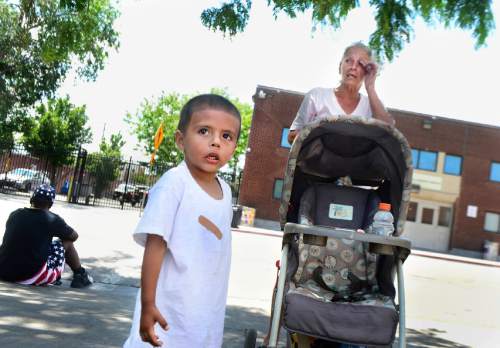This is an archived article that was published on sltrib.com in 2016, and information in the article may be outdated. It is provided only for personal research purposes and may not be reprinted.
At least 20 percent of Utah's homeless are women and children who are victims of domestic violence.
And more mothers and kids are being served at The Road Home shelter each year with expectations that those numbers will grow.
One in three women in Utah will experience domestic violence in her lifetime, according to Rene Malecki, director of the Salt Lake Area Family Justice Center at the YWCA.
"While we know domestic violence is a leading cause of homelessness among families and children in Utah, we also know that domestic violence breeds in silence and is an underreported crime," she said. "Evidence of domestic violence is not always physically visible — as it can be in the form of emotional, financial, sexual and electronic abuse.
The notion that homeless people are all drug addicts or mentally ill, officials say, is misguided. Nonetheless, a recent report from the Utah Foundation — a nonpartisan, nonprofit public-policy research group — states that 29 percent do suffer from mental illness and 23 percent are substance abusers.
The foundation's "research brief" on homelessness and poverty highlights homeless subgroups and the ongoing challenges facing Utahns who seek respite in Salt Lake City from homeless-service providers. The enterprise is part of the foundation's Utah Priorities Project on issues important to voters.
According to the report, homelessness in Utah is at a 10-year low. The annual Point in Time count in January put Utah's homeless population at 2,807. In 2009, it was 3,527. It also states that homelessness among families is down 19.5 percent.
The most recent data may be misleading, however, because the U.S. Department of Housing and Urban Development changed its protocols for the 2016 survey and did not tally people in transitional housing who were previously counted.
Although The Road Home's new Midvale shelter houses 300 people, its Rio Grande Street facility remains near capacity.
Family homelessness in Utah is actually up 17 percent, said Shaleane Gee, who heads Salt Lake County's Collective Impact program, which seeks to coordinate homeless services in search of better outcomes.
About 40 percent of Utah's homeless are families, she added. Domestic-violence victims fall within that group, along with families who have become homeless after financial setbacks.
"They may have lost a job, had a health crisis or have a disability," Gee said. A new focus is on "how can we help those who need help before they become homeless?"
It's much easier to help families before they lose their homes than it is to get them back on their feet once they become homeless.
The homelessness problem is complex. Each case is unique.
For example, Kathy Maestas, 57, who was living with her mother, has been homeless for two years. She has sole custody of her 3-year-old grandson, Navin Maestas. The two became homeless when Kathy's mother died and her stepfather put them out, she said. Navin's mother is in prison.
"We got approved for rapid rehousing," Kathy Maestas said of The Road Home's program to help with rent. "But my credit is bad, so nobody will rent to us."
Poverty is a major contributor to homelessness, according to the foundation's report. Some 339,900 Utahns live in poverty — 11.7 percent of the population. Moreover, the state has a shortage of 46,036 affordable-housing units for low-wage earners. Although the unemployment rate is 3.8 percent, wages have been suppressed since the Great Recession. And the report states that 12.5 percent — one in eight Utahns — have no health insurance.
Lack of affordable housing and expensive health care rank among the chief reasons families lose their homes, Gee said.
Although private entities and local governments are making strides tackling the multifaceted problem, many Utahns say homelessness is becoming more visible, according to the Utah Foundation's report.
A foundation survey revealed voter differences based on political preferences. Some 48 percent of self-described conservatives rated poverty and homelessness as being of "high concern." By contrast, 75 percent of self-described liberals found the issue to be of "high concern."
Voters' income levels also showed a divergence of views. About 63 percent of respondents with annual incomes under $25,000 rated homelessness as a "high concern," compared with 45 percent of those with incomes above $100,000.
Earlier this year, the Utah Legislature allocated $9.25 million for new shelters and services. It is hoped similar funding will be made available during the next two sessions. Among other initiatives, the money would pay for two new shelters, each capable of housing 300 people.
But new buildings won't be enough, Gee said.
Many in the subgroups of substance abuse and mental illness find themselves in a vicious cycle, jumping from the street to jail to the shelter and back, over and over again, Gee said. Coordinating the criminal-justice system with homeless services and health care, including mental-health care, is critical to breaking that cycle.
After 18 months of work, Gee said, Collective Impact understands better than ever how people are moving in and out of the homeless system, how they came to it and where they are going.
"[Success] is not going to happen overnight," she said. "But we are looking at all parts of the system, including public safety, public health, housing and poverty in schools."



